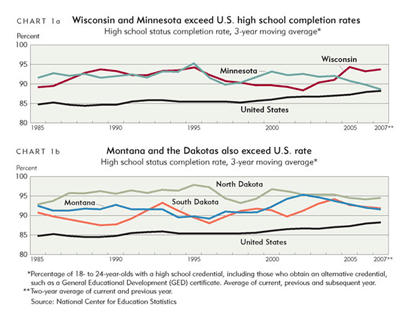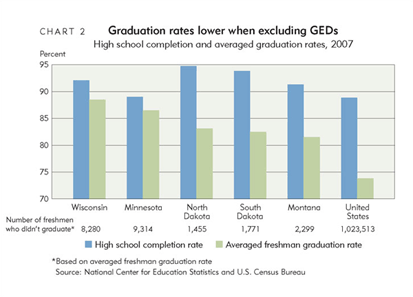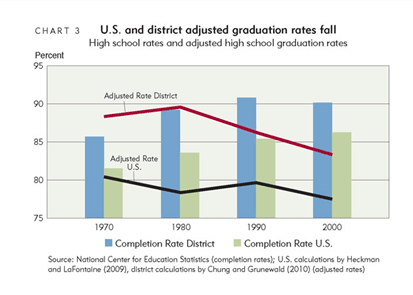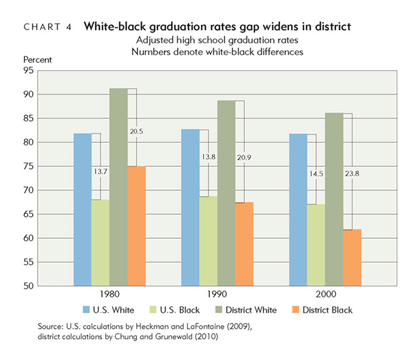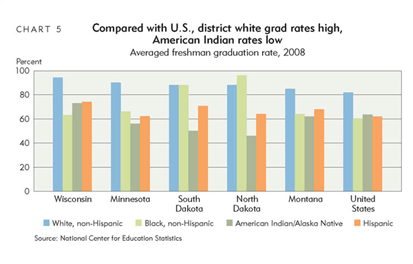Ninth District states boast strong high school completion rates, ranging from 89 percent in Minnesota to almost 95 percent in North Dakota in 2007, and have consistently outperformed the national average on this measure (see Chart 1). National data also show that high school completion has been increasing since the 1960s and that the gap between white graduation rates and black and Hispanic rates has been closing.
However, the methodology used by the National Center for Educational Statistics to calculate high school completion rates (graduation or equivalent) raises some questions about their accuracy. For example, James Heckman, Nobel laureate economist at the University of Chicago, and his colleagues argue that General Educational Development (GED) certificate holders and immigrants never enrolled in U.S. secondary schools should not be counted as high school graduates.
This fedgazette analysis considers alternative measures and makes adjustments to the high school completion rate, which is the percentage of 18- to 24-year-olds with a high school credential, including those who obtain an alternative, such as a GED certificate.
These measures suggest that the national and district completion rates are considerably lower compared with the traditional measure and that the gap between white and these minority graduation rates has not closed since the 1960s. They also imply that policymakers shouldn’t get too comfortable with high school completion rate statistics. Improving graduation rates, particularly among black, Hispanic and American Indian populations, has a ways to go.
The case for excluding GED holders
The existing high school completion rate includes GED certificate holders, which seems reasonable because GEDs are awarded to students in lieu of finishing high school by passing tests in five subjects. However, research by Heckman and his colleagues has demonstrated that after corrections are made for differences in ability, GED holders earn levels similar to those of high school dropouts. Other studies show that GED holders are far less likely than high school graduates to finish 2-year or 4-year college degree programs.
Despite these findings from aggregate GED statistics, there are plenty of reasons at the individual level for a high school dropout to achieve a GED. A high school diploma or GED is often required for post-secondary education programs or entry-level jobs. Nevertheless, Heckman argues that meaningful high school graduation statistics should exclude GED holders.
When a measure that excludes GEDs is used, the averaged freshman graduation rate of public high school students divides the number of public high school diplomas issued in a particular year by the average membership of the 10th-grade, 9th-grade and 8th-grade classes two through four years earlier. The rate essentially measures the percentage of freshmen who graduate from public high schools but, unlike the high school completion rate, doesn’t include students who attend private schools or students who drop out of school before the 8th grade. U.S. and district averaged freshman graduation rates are lower than completion rates (see Chart 2).
The gap between district and national graduation rates is much wider when GEDs are excluded, compared with the high school completion rate, because GED holders represent a smaller percentage of the district population compared with the nation. Nevertheless, a sizable number of district high school freshmen don’t graduate from high school. In the 2006-07 school year, more than 23,000 students in district states who finished their freshman year three years earlier did not graduate.
More than GEDs
Excluding GED holders from the high school completion rate is not the only adjustment that could improve the estimate’s accuracy. Heckman and Paul LaFontaine, also affiliated with the University of Chicago, point out three additional concerns. First, since the high school completion rate is based on data from the Current Population Survey, the institutionalized population—those in the prison or the military—is not included. Second, the completion rate includes immigrants who moved to the United States but were never enrolled in U.S. secondary schools; counting these immigrants biases the completion rate downward. Third, respondents to the survey likely confuse the response options to a question regarding education attainment.
Heckman and LaFontaine use census data from 1970, 1980, 1990 and 2000 to make these adjustments. They find that the adjusted U.S. high school graduation rate was 77.5 percent in 2000, 8.8 percentage points below the high school completion rate. Furthermore, they show that the high school graduation rate did not increase from 1970 to 2000.
These same data adjustments were made to the five district states as a group (states were aggregated to achieve a large enough sample to make the adjustments). Similar to the national results, the adjusted high school graduation rate for the district in 2000 also declined, in this case 6.7 percent from its original or “official” measure to 83.4 percent. However, similar to trends noticed with the completion rates, over time the gap between the district and the nation closed, from 11.1 percent in 1980 to 5.9 percent in 2000 (see Chart 3).
White-minority gap remains wide
High school completion data also suggest that the gap between white and minority high school completion rates has been closing since the early 1970s. For example, the difference between white and black high school completion rates decreased from 12.3 percent in 1980 to 8.5 percent in 2000. However, after Heckman and LaFontaine make adjustments to the high school completion rate, the gap between white and minority high school graduation rates remains unchanged over this time period. In the case above, the gap between white and black graduation rates actually rose slightly, from 13.7 percent in 1980 and 14.4 percent in 2000 (see Chart 4).
The primary reason the adjusted high school graduation rate shows increased gaps between white and black rates is the exclusion of GED holders. In 2000, 10 percent of U.S. white male high school completers aged 20 to 24 had a GED, while 16 percent of black male high school completers aged 20 to 24 had a GED. Once the high school completion rate adds GED holders into its figures, the black completion rate catches up with the white completion rate.
Because the district data sample used to calculate annual high school completion rates is too small to calculate consistent minority graduation rates over time, it’s not clear whether the gap between district white completion rates and black and Hispanic rates has been closing. But when the Heckman-LaFontaine adjustments are applied to census data, the difference between district white and minority graduation rates widens. In 1980, the difference between white and black graduation rates was 20.5 percent; in 2000, the difference increased to 23.8 percent, a bigger gap than seen in national figures (see Chart 4).
For a state-by-state view of graduation rate gaps, we turn to the averaged freshman graduation rate. On this measure we find large gaps between white and black and Hispanic graduation rates in Wisconsin and Minnesota in 2008 (see Chart 5). Note that black and Hispanic high school students combined in Montana and the Dakotas represent less than 3 percent of total graduates; therefore, these graduation rates are somewhat volatile from year to year.
The relatively large differences in white-black and white-Hispanic graduation rates in Wisconsin and Minnesota are largely due to strong performance among white students rather than relatively poor performance among black and Hispanic students. Graduation rates among white students in Wisconsin and Minnesota were 13 percent and 9 percent, respectively, higher than graduation rates among white students nationally.
Differences in graduation rates between white and American Indian students are also wide, including 41 percentage point and 37 percentage point differences in North Dakota and South Dakota, respectively, where American Indian students represent more than 5 percent of total graduates. In Montana, where almost 9 percent of high school graduates are American Indian, the difference is 21 percent. All district states, except Wisconsin, have lower American Indian graduation rates than the nation.
Graduation rates for Asian/Pacific Islander students are not listed in Chart 5, but nationally are higher than white graduation rates: 91.4 percent compared with 81 percent in 2008. In the district, Asian/Pacific Islanders represent 1 percent or less of graduates in Montana and the Dakotas, almost 4 percent in Wisconsin and almost 6 percent in Minnesota. In 2008, Asian/Pacific Islander graduation rates were higher than white graduation rates in Montana, South Dakota and Wisconsin, and slightly lower in Minnesota and North Dakota.
The adjusted high school graduation rates and averaged freshman graduation rates show that rates among black, Hispanic and American Indian students in the district and the nation are much lower than policymakers and others would like to see. If they look only at the high school completion rate, these white-minority graduation rate gaps and the overall graduation rate may look a little too rosy.
More on the district high school graduation rate study:
Measuring the High School Graduation Rate
in the Ninth Federal Reserve District [PDF]




